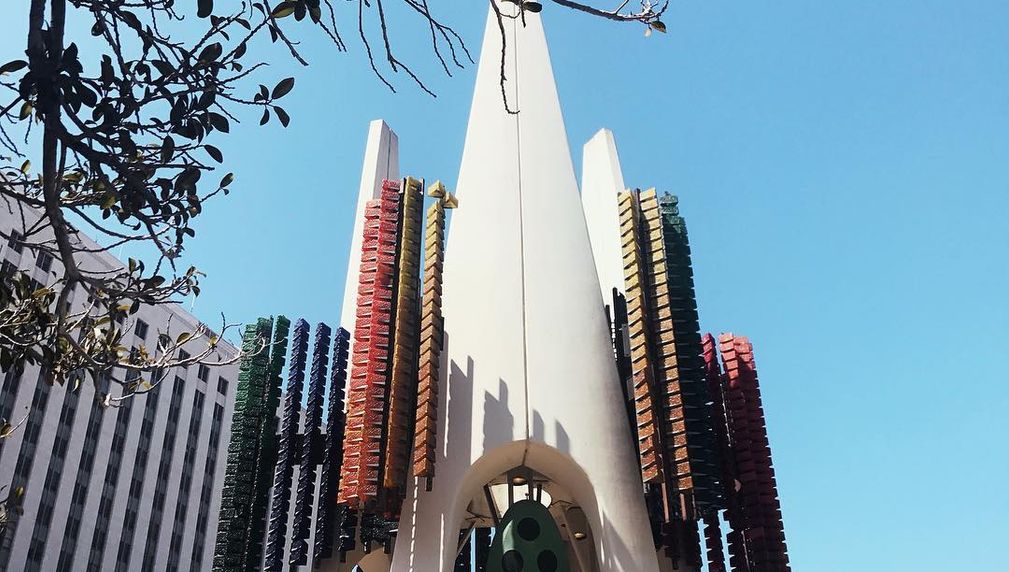Restoring and reimagining the World's First 'Polyphonoptic' sculpture in downtown Los Angeles
The Triforium is a piece of “polyphonoptic” public art in DTLA that was 40 years ahead of its time; we want to restore and retrofit it to achieve the artist's dream of music, community, and wonder.

Are any other organizations collaborating on this proposal?
5 Every Day, Tom Explores Los Angeles, Downtown Art Walk, Art Share LA
Please describe your project proposal.
The Triforium is a six-story, 60-ton public artwork in Downtown Los Angeles. Its original design was for a polyphonoptic sculpture lighting up in synchrony to music and human movement. It was ahead of his time, and never worked as intended. We want to retrofit and reimagine the Triforium, replacing its incandescent bulbs with LEDs and a nimble computer system to achieve Joseph Young’s original goals. We want to create an app that'll allow people to create compositions for the Triforium to play.
Which of the PLAY metrics will your proposal impact?
Access to open space and park facilities
Number (and quality) of informal spaces for play
Perceived safety
In what areas of Los Angeles will you be directly working?
Central LA
Describe in greater detail how your proposal will make LA the best place to PLAY?
Imagine if you could control the individual street lights in Chris Burden’s “Urban Light.” Imagine they made music. How would that artwork, already such a magnet, inspire new forms of play? That’s what the Triforium could be: a place where people and technology meet to make music, light, and wonder.
Joseph Young designed the Triforium as 'the Rosetta Stone of art and technology,” using motion sensors and a computer system to translate pedestrian footfall in the nearby LA Mall into patterns of light and sound displayed by prisms and the glass bell carillon, at the time the largest musical instrument in the world. It didn’t quite work out that way.
But time has caught up to Young’s vision: replaced with LED bulbs, the Triforium’s lights could last longer, burn brighter, and respond to an inexpensive computer system designed to invite musical interaction. Motion-sensitive components could allow pedestrians not only to look at the sculpture but to dance with it.
The interactive urban light is not only possible—it can move from the streets and into the pockets of Angelenos. Using a free Triforium app, Angelenos of all ages could create simple compositions and “play” the instrument in public space. This is interactivity as Joseph Young could never have imagined it. It is networked, creative, and will meet citizens where they are—between the digital and the physical, between the wide world and the city.
Los Angeles is the most park-poor major city in America, and we need fully utilize what little open space we have in the city. The Triforium stands in the shadow of City Hall, a stone’s throw from Grand Park, in Fletcher-Bowron Square. Flanked by a bike lane and located near dozens of Downtown landmarks, it’s an underutilized public square with a history both inspiring and largely unknown by the public.
Restored to its intended grandeur, the Triforium can become an opportunity for pedestrians, downtown workers, tourists, children, artists, and commuters in Los Angeles to stop, play, and illuminate the city. It will encourage sustained collaborative play; the more people interact with the instrument, the more brightly it will shine.
As Los Angeles’ historic Downtown finds itself at the center of massive civic reinvestment, we look to the Triforium restoration as a positive metaphor for the ways in which urban renewal can revitalize from the inside. By investing in the neglected infrastructures all around us, we honor and preserve the city’s rich history while weaving it seamlessly into the fabric of the future. The thousand-plus points of light radiating from the Triforium are reminders of all the Triforia everywhere—the faded municipal underpinnings in every city that we take for granted, and which with modest preservation can serve our cities in ways well beyond what their architects ever imagined.
We see the Triforium as a beacon. It’s been there all along. We just need to turn it on.
Please explain how you will define and measure success for your project.
Our baseline measure for success will be the basic restoration of the Triforium to its intended functionality: all 1,494 multicolored glass cubes cleaned and the incandescent bulbs within them replaced by LED bulbs, the 40 year-old wiring updated to modern safety and efficiency standards, and the room-sized machinery at its feet replaced by a programmable computer networked to the bulbs and an updated instrument that aurally evokes the sculpture’s original 79-note glass bell carillon. With the free app that will allow the public to interface with this piece of public art, we can count downloads and active users per month. These are the quantifiable indices.
The real measure, however, will be on the ground in Fletcher-Bowron Square: if Angelenos begin to gather in this vastly underutilized public space during the day to play music together, and at night to see their music light up the heart of the city, we will know we have succeeded.
How can the LA2050 community and other stakeholders help your proposal succeed?
Money
Volunteers
Technical infrastructure (computers etc.)
Community outreach